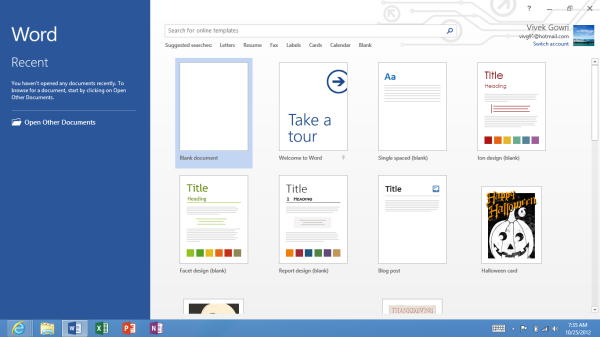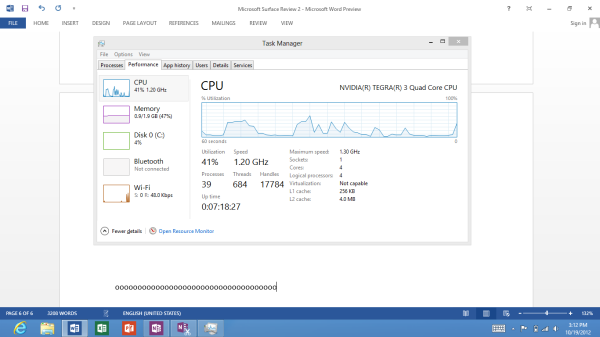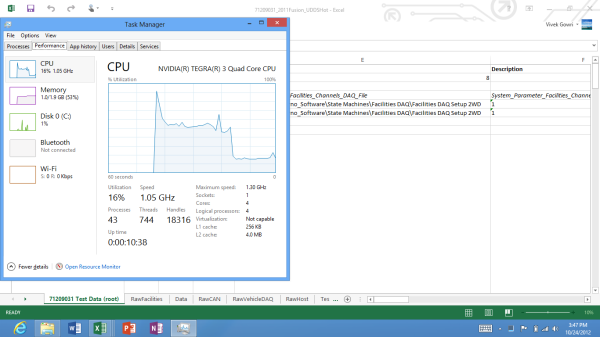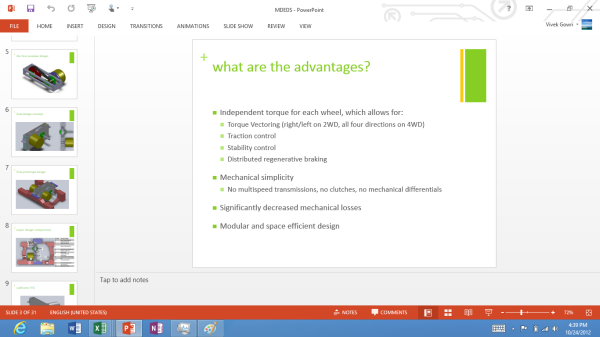The Windows RT Review
by Vivek Gowri & Anand Lal Shimpi on October 25, 2012 12:00 PM EST- Posted in
- Windows RT
- Operating Systems
- Microsoft
- Mobile
- Windows 8
- Tablets
Office 2013 for Windows RT
Office 2013 is the headlining application for Windows RT. And it’s a pretty big deal - this is the first time we’re seeing the full Office experience reach a modern tablet platform, at least in the first party sense. In the smartphone world, this wasn’t as much of a distinguishing factor as Microsoft hoped it would be when they included a mobile version of the full Office suite in Windows Phone 7, but that’s because there’s relatively little scope for document creation or editing on handhelds. In the tablet world though, it’s huge. For a tablet to truly be a viable replacement for a notebook, office productivity needed to be addressed.
So Microsoft decided to do something about it: Office 2013 Home and Student Edition ships as a pre-installed part of every single Windows RT tablet. And just like that, almost every non-engineering student I know could get away with a Windows RT tablet as their primary computing device, provided they aren’t gamers or aren’t attached to the idea of local storage. It’s something I couldn’t say about the iPad or any of the Android tablets out there. But I’m getting ahead of myself here. Let’s look at the applications themselves.
Office Home and Student contains Word, Excel, PowerPoint, and OneNote, so you get the core three productivity applications, as well as the one with the most potential for tablets. The one application that will probably be missed most is Outlook, but with Outlook account support for both the Mail and Calendar apps, enough of the functionality is still available. Outlook is more power-user oriented than either Mail or Calendar, but when it comes down to it, Windows RT was created to serve a more consumer-oriented market segment that typically doesn’t rely on the more intricate functionality of Outlook.
Design was always the biggest question about creating a mobile office suite. How much would Microsoft be willing to change the interface to suit a touchscreen input? How much functionality would that give up? How would Excel even work? I don’t actually have an answer, but here’s where the thinking went: why bother designing a touch-centric typing or spreadsheet app if most people are going to turn to a physical keyboard to use it anyways? And it’s a line of reasoning that makes sense - beyond going completely to voice control, I cannot see myself using any word processor without touching a physical keyboard. And many of the more complex functions of Excel, like formulas and macros, would be near impossible to replicate on a touch-centric UI without neutering a decent amount of the power and control users have.
So, instead of redesigning Office to fit within the new Modern UI guidelines, Microsoft simply ported the x86 version of Office 2013 over to ARM and runs it as a desktop application. I can’t blame them - Office 2013 was redesigned with the Metro design language, so it already fit the Windows RT visual style, and it was just easier for them to not mess with the UI or UX further. But that’s actually a good thing - Office is the killer application for RT because it functions exactly the same as Office 2013 on any other system. If you live in the world of Office 2013 and SkyDrive, this is fantastic news because you need to make almost no adjustments to your workflow. It’s just as capable and powerful on here as it is on any other Windows system.
Office isn’t perfect, and you can level any number of complaints at it - aggravating at times, uses proprietary file formats, resource intensive, expensive, difficult to learn, and I’m only scratching the surface. Based on my usage of the Office 2013 Preview on Windows 7 and RT, it’s actually my favorite version yet, so there’s that, but the main point is that this is still a full-fledged version of Office that we’re talking about here. Over the last two decades, people have learned to put up with its quirks and faults, and it’s still one of the single most important pieces of productivity software on the market.
So, how does it all work? Pretty well, all things considered. All of these applications are pretty much exactly as you would find on an x86 PC, so I’m not going to go very far into the design and functionality, though there are a couple of interesting use-cases that I’ll bring up later on. The most critical concern I had going into Office on ARM was performance - the reputation for being a resource-intensive software suite is not undeserved, let’s put it that way, and quad-core A9, great as it is, doesn’t have the raw compute horsepower of Atom much less Core 2 or any newer Intel processor.
In Word, it’s relatively easy to pull 30% CPU utilization when typing quickly. Anand saw up to 40% on Surface, and I managed to get CPU utilization all the way up to 55% when pressing random keys as quickly as possible. Compare this to Notepad, which usually hovers in the 5-10% CPU utilization range, and it’s clear to see how heavy a load Office puts on the system. Even with the high CPU utilization though, I never saw any lag in the characters appearing, so it’s mostly an interesting point to note and not an issue with the typing experience.
Update: Microsoft shared an official response with us about the high CPU utilization we're seeing:
Increases in CPU utilization while typing are an expected behavior in Word, but should not extend beyond the immediate typing. However, we are always looking at ways to improve CPU utilization and the customer experience with Office.
To really push the system, I loaded up some of the Excel files I work with at my real life job as an automotive technology researcher. These are raw and mostly unprocessed dynamometer data test files, with roughly 3 million data cells each (give or take.) The largest had just under 4 million data cells and was 39MB in size, smallest about 1.8 million and 19MB in size. A couple of graphs and some equations. Together, the four files totaled 112MB. I decided to open all four at once - it took about a minute and a half, with a max CPU load of 72%. It was crazy, but once everything was loaded, performance was actually decent. I wouldn’t want to necessarily work on the files for extended periods with a system like this - the screen is too small, and the couple of bits of lag would drive me nuts (plus, without Matlab, it’s a bit pointless) but for quick graphing of basic data, it works significantly better than expected.
The good thing is that there’s a lot of RAM here - with 2GB seeming to be the default for Windows RT tablets you’re rarely memory starved. So even with 250MB worth of RAM dedicated to Excel, CPU headroom is still the main limiting factor. For more basic Excel tasks, like the chemistry labs that were commonly assigned in undergrad, there’s definitely more than enough power here. The files I loaded up are typically only manipulated on quad-core workstation notebooks and are far and away an extreme use case.
I didn’t really spend a whole lot of time in PowerPoint, because I typically don’t use it very much. I loaded up a presentation I gave late last year about some of my research at the time, and started editing it to see if the experience had anything different to mention. Performance seemed good enough, with maybe a hint of frame drop when scrolling through the slide thumbnails on the right edge (it moves at something closer to 25 FPS than 30). I liked the ability to swipe back and forth between slides when in Presentation mode, that’s one nice thing about the tablet interface. Other than that, this is just PowerPoint on a smaller screen.
OneNote is the one that I was really interested in. Because even though it runs within the framework of the Windows desktop, it’s an application that really lends itself to tablet usage. Back in the tablet PC days, OneNote was the killer usecase, the one program that really lent itself to being used in conjunction with pen-input. I came very close to buying a Wacom-enabled tablet on numerous occasions for the specific purpose of taking electronic lecture notes with OneNote. (It never happened, and I ended up taking very few notes of any kind through college, but such is life.)
Now, without active digitizer support on most Windows RT tablets (I haven’t seen any with active digitizers), you’re limited to either keyboard or capacitive touch input. This is where the handwriting panel comes in, and like I mentioned before, it’s quite good even when you’re just using your finger to write. With a capacitive stylus (which I regrettably do not have on hand) I can see this being legitimately useful to take handwritten notes on. It’s good enough that you can get away without a Wacom-enabled tablet if you don’t want to shell out the extra $400 or so. I genuinely wish something like this was available when I was still in the notetaking phase of college, many moons ago - the fifteen year old me would have killed to have a $600 tablet with solid handwriting recognition, even without an active digitizer.
And that’s really what makes Office for Windows RT interesting. It gives you 95% of the office suite experience and capability of any normal desktop or notebook PC in the modern tablet form factor, introducing some much needed productivity into what was previously a very content-consumption oriented device category.















233 Comments
View All Comments
steven75 - Friday, November 2, 2012 - link
You are either truly delusional or have no idea the limitations of RT.-It can't join a domain.
-Office is the student/home edition. No Macros, no plugins, etc.
-95% of the fortune 500 has already deployed iPads.
chavv - Friday, October 26, 2012 - link
so, the only "real" browser will be IE10?And what about support for card readers/certificates?
Can one use certificates to sign documents?
thesavvymage - Friday, October 26, 2012 - link
Really REALLY hope the folks over at VLC or many of the android video players get an app onto windows RT for mkv playback! Almost any anime is in this format with advanced subtitles, and itd be absolutely amazing to have this tablet on my daily university bus commute if it supported those video files :)Pressurge - Friday, October 26, 2012 - link
that the review for the yearly refresh of iOS got a much greater, in-depth review than the first-ever version of Windows running on ARM, including the fact that it's on a Microsoft-designed/spec'd tablet. "Hey, let's do three pages worth of review just on the new Maps app, but nothing in Windows RT deserves that type of in-depth analysis at all!"There appears to be no end in sight to the massive time investment towards all things Apple on Anandtech while everything else gets filler articles/reviews at best...
Che - Sunday, October 28, 2012 - link
+1hakime - Friday, October 26, 2012 - link
"It’s unclear how big this convertible/hybrid market will grow, but I see real potential here."Keep dreaming.....
"The iPad and iOS remain a very polished, very accessible platform that is really optimized for content consumption and light productivity. For anyone who wanted more however, there’s now an alternative: Windows RT."
"The default inclusion of Office 2013 and the emphasis on physical keyboards makes Windows RT the first tablet platform to significantly address the question of productivity."
Reading this review, it strikes me that people at Anandtech either are totally biased towards Windows (which wouldn't be new, see also the Surface review) or they've never used an iPad. I put my money on the first one. Because you can't possibly claim that the iPad is less productive than a tablet with Windows RT, you really can't unless your are out of your mind.
There is nothing that makes Windows RT more productive than iOS because you seem to have missed that it's iOS which has the productive apps today. Windows RT has nothing, nothing, and it will stay like that for a long time. If you want to be productive with a tablet today, you get an iPad not a tablet with Windows RT, period. iOS has productive apps that cover everything from video, audio production to art, photo workflows and text editors, CAD, etc.. All of them are optimized for touch. With Windows RT, to be productive you just get Office that you really can't use freely because of the restricted license. Office forces you to use a keyboard attached to a tablet and because such keyboards are very limited, you can't really use it with an attached keyboard either. What a mess.....
"Combined with the equally advanced task switching and multitasking built into the UI, and this becomes the first legitimately useful tablet operating system out there."
Then you are really not making sense, it's amazing. The multitasking on Windows RT is nothing better than iOS, it actually works the same way. The only thing is that it allows to put a stripped down app besides another one but this feature is not very useful on tablet screens. And this feature only exists because Windows RT has a fundamental flaw that this review completely ignores. Windows RT forces you to use a tablet in landscape mode (hence more room for the Snap feature) but at the price of sacrificing tremendously the usability of the system when used as a tablet (a shame when the system is supposed to be for tablets) because it's difficult to use the tablet in this mode without any attached keyboard. And by itself, Windows RT is more designed for consumption than being useful for production because of the choice of this landscape mode as default mode and also because the "Metro" interface is designed to be eye candy and only makes sense for content consumption apps. The interface is actually rather limited and constraining when it comes to have freedom in building any type of apps. So claiming that Windows RT is the first legitimately useful tablet operating system out there is at the limit of being a total troll who is disconnected from the reality. In the real world today, Windows RT is the less useful tablet OS out there not only because it lacks apps, but also it's design does everything in order that this OS is limited to content consumption.
"Every single Windows RT slate comes out of the box with Office and the ability to have multiple active application windows. It’s just a few steps ahead of competing tablet platforms at this point."
Again Office is not very useful on Windows RT, its useless in touch mode, hard to use with those Type Covers or whatever else, so it's just bad... There is absolutely not advantage over competing platforms here, absolutely none...
"From a conceptual standpoint, almost anything you can do with an iPad can be done equally well (or close) on a Windows RT tablet"
No it can't because it lacks apps and polish. The metro interface is too confusing, too busy, actually too much eye candy in order to hide the reality of an OS which is technically behind. I am amazed to see that the authors did not really point out the incredible deficiencies of the built-in apps. Mail, Messaging, Calendar lacks basic features to the point of being useless, IE 10 is buggy like the rest of the OS which often feels sluggish and lacks stability. I mean a dude in the iPhone 5 review came up with some completely baseless, unreal theory of scuffs affecting the iPhone 5, describing in length a completely baseless theory of an iPhone 5 production that the author in fact had not idea of. Like often in Anandtech and when it's about Apple, the authors go in lengthy baseless analysis that they don't have the real competence to do, but they do it anyway just to appear smarter than they are in reality. So we've got an iPhone 5 review where we were still being told about the AntennaGate, something that never existed and now also about a new Scuffgate which also does not have any real existence besides being some minor manufacturing issues on some units. Today, we've got a flawed software from Microsoft, I mean Microsoft sells you a half featured Mail app and buggy software but no word on that from the authors, no words on whatever gate. The authors of Anandtech really lacks honesty, you've got to get your ch.. together guys, really!!
"but the desktop-caliber office suite and versatile multitasking interface of Windows RT are impossible experiences to replicate on the iPad"
Oh yes sure because the iPad is not trying to run a desktop app on a touch devise. Yes indeed!!! Did you really use Office on Windows RT, honestly, say the truth? Office is unusable with fingers, it requires an atached keyboard which also is crap and comes with a completely, insanely bad trackpad. Please explain how this is supposed to be an experience that the iPad should replicate? On the other hand, iWork on iPad is a desktop caliber suite which is designed to work with touch. Which one you use?
You keep speaking about this multitasking thing like you are really trying hard to find something to like in Windows RT. The reality is that the multitasking on Windows RT works like iOS with extra poorly implemented features most of the time not very useful on a tablet screen and which forced a design decision that really messes up the ease of use of Windows RT as a tablet OS.
"if you’re looking for a new tablet this fall, Windows RT deserves your consideration. "
Yes sure, if you want a buggy OS, designed towards content consumption, with limited and buggy built-in apps and no apps to use besides them, sure go ahead....
maximumGPU - Friday, October 26, 2012 - link
I always find it funny that the same person (Anand) can be accused of being both an apple fanboy and a microsoft fanboy in different articles, and sometime in the same one. This just shows you that it's only commentators like you who are one.You're (extremely boring) reply has nothing of substance except personnal opinions and baseless attacks.
i have owned every ipad (and still own the 3rd one), and i agree with the article in that productivity is limited on these tablets.
maximumGPU - Friday, October 26, 2012 - link
Oh there it is, check a few posts down and the user "milkod2001" calling Anand an apple fanboy...ludikraut - Friday, October 26, 2012 - link
but which world are you living in? Seriously."...Reading this review, it strikes me that people at Anandtech either are totally biased towards Windows (which wouldn't be new, see also the Surface review) or they've never used an iPad. I put my money on the first one. Because you can't possibly claim that the iPad is less productive than a tablet with Windows RT, you really can't unless your are out of your mind...."
The only one out of their mind is you. Have you actually used Windows RT - or even Windows 8 - on a tablet? Didn't think so.
"...There is nothing that makes Windows RT more productive than iOS because you seem to have missed that it's iOS which has the productive apps today..."
I think you're confusing productivity with productive.
"...Then you are really not making sense, it's amazing. The multitasking on Windows RT is nothing better than iOS, it actually works the same way. The only thing is that it allows to put a stripped down app besides another one but this feature is not very useful on tablet screens..."
And here you manage to contradict yourself in the span of two sentences. I won't bother to pick apart the rest of the post, I'd be here all day. Next time ... think before posting and check your facts ... please?
l8r)
steven75 - Friday, November 2, 2012 - link
Have you ever used an iPad? Have you used the iWorks apps on one? Do you realize a keyboard not only works with an iPad but is not a totally necessity unlike with Office on Windows RT?I am in complete agreement the reviewer doesn't have any experience with iPad productivity apps or is living a life completely shacked to Microsoft Office.